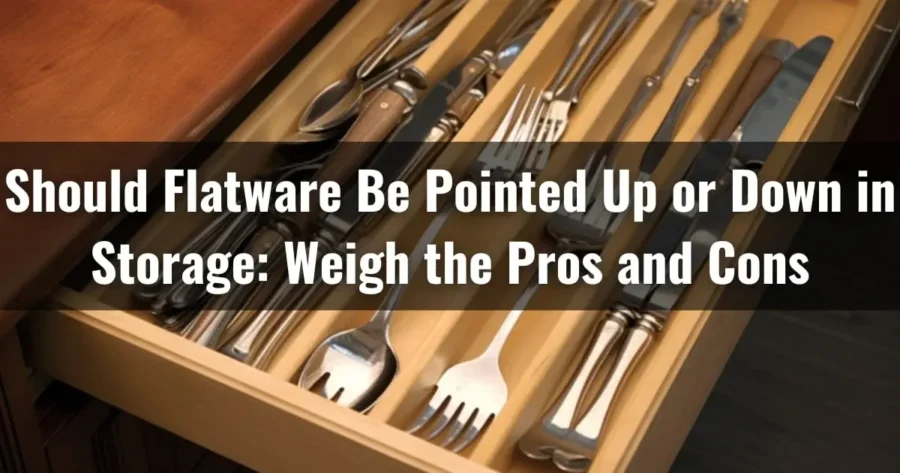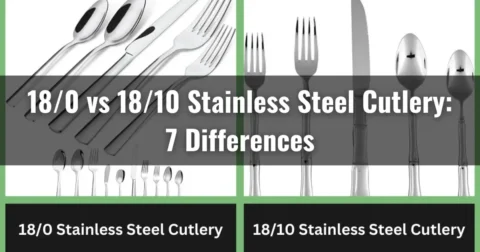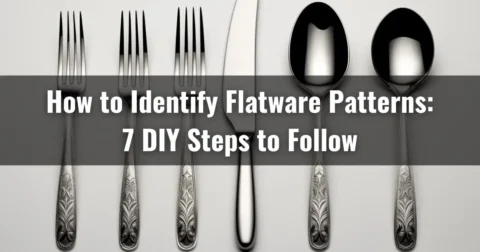When you need to store your flatware in your kitchen flatware storage, the question of whether it should be pointed up or down is often perplexing.
It’s a topic that sparks debates among kitchen enthusiasts, each offering their own reasoning behind their preferred method.
Some say that pointing the flatware handles up is the way to go, citing ease of access and safety as their main arguments.
Others firmly believe that handles should be pointed down, asserting that this keeps part of the utensils that touch your food cleaner and more sanitary.
The choice between handle-up or handle-down storage in a flatware organizer is highly subjective and dependent on your personal habits and priorities.
While some may prioritize convenience and safety, others may lean towards maintaining the utmost cleanliness of their eating utensils.
We’ll explore the pros and cons of both approaches to assist you in deciding based on your specific needs and preferences.
Jump to Section
Pointing the Flatware Up and Down in Flatware Storage: Pros and Cons
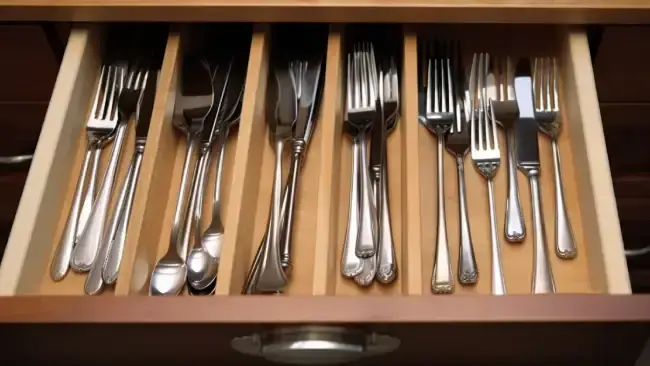
The flatware handles can be stored up or down in kitchen flatware storage. But before you decide which option is best for you, you should consider the pros and cons of both options.
- Pros & Cons of pointing flatware handle up
- Pros & Cons of pointing flatware handles down
Let’s check out each pros and cons in detail so you can decide which is the best solution for storing flatware.
1. Pros of Pointing Flatware Handles Up
When storing your flatware, there are several advantages to pointing the handles up. The following are among them:
1. Hygiene
Storing flatware with handles up helps ensure that you don’t touch the part of the utensil that comes into contact with food when unloading it. This practice promotes better hygiene in your kitchen.
By avoiding contact with the eating surface of the flatware, you reduce the risk of transferring germs or contaminants onto the utensils. That’s why some people prefer to store flatware with handles up.
2. Safety
Another reason for storing your flatware with handles up is for safety purposes. You may not realize it, but reaching into a drawer or storage container can expose you to the sharp edges of your knives.
If your knives are stored with handles up, you will reduce the risk of accidentally cutting your fingers when you reach for them. This is especially important when dealing with sharp, serrated knives that can cause serious injury.
To reduce the risk of accidental cuts, ensure your knives are stored with their handles facing outward. Keeping the blades facing down minimizes the chances of accidentally grabbing the sharp edge and injuring yourself.
3. Space Efficiency
By positioning the handles upward, you can create more room in your drawers for other items. Storing flatware with handles up maximizes space because the narrower parts of the utensils take up less room. This allows you to fit more items into the same drawer.
When organizing your flatware, remember to stack them neatly to optimize space further. This practical and efficient method ensures more storage space for other kitchen essentials.
2. Cons of Pointing Flatware Handles Up
You may encounter some drawbacks when you store your flatware with the handles pointed up. These are:
1. Nesting
Regarding flatware storage, one of the potential drawbacks of pointing flatware handles up is nesting. Nesting occurs when utensils are stored so that they stack closely together in the storage container or drawer.
This can lead to a situation where the utensils become intertwined or tangled, making it more challenging to access them easily.
Flatware storage intends to ensure that your utensils are organized, easily accessible, and free from potential damage. Therefore, the nesting issue can hinder this intent, as it may require extra effort to disentangle the utensils when needed.
2. Overcrowding
Storing flatware handles up can lead to overfilling the drawer or container, making it difficult to access utensils and increasing the risk of scratching.
Overcrowding can occur when utensils are stored vertically, as it is difficult to view the contents and, therefore, challenging to stack them neatly.
Additionally, overcrowding makes it harder to identify utensils when needed quickly, leading to frustration and wasted time.
Such haphazard stacking can also result in utensils hitting each other and causing scratches and damage.
Pros of Pointing Flatware Handles Down
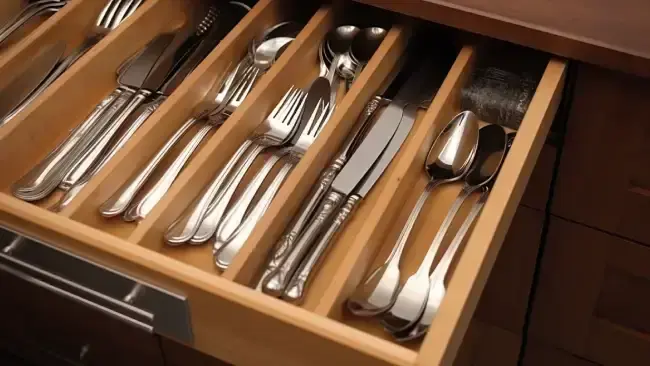
When storing your flatware, pointing the handles down has several advantages. The following are among them:
1. Prevents Nesting
Storing flatware handles down is a choice favored by many for flatware storage, and it offers certain advantages when organizing your utensils. One notable benefit is that it effectively prevents nesting.
When flatware is nestled together with handles down, it ensures that each piece remains neatly separated from the others.
This separation minimizes the chances of utensils getting entangled or intertwined. It can be especially advantageous when maintaining an orderly and easily accessible flatware storage arrangement.
By preventing nesting, you create a more streamlined and efficient storage solution, allowing you to retrieve specific utensils without having to untangle them.
2. Prevents Scratching
Another advantage of storing your flatware with handles down is that it helps prevent scratching. When utensils are stored with the handles up, they are more likely to rub against each other, leading to scratches and dents.
Scratches detract from your flatware’s appearance and can compromise its effectiveness.
For example, a scratched knife blade may not cut as well as a sharp one. By storing your flatware with handles down, you can protect the appearance and quality of your utensils.
3. Easier Access
You’ll find it much more convenient to grab utensils quickly and set the table when you store the flatware with the handles down. Doing so gives you easier access to your flatware, saving you time and effort.
This method allows you to effortlessly grab the utensils you need without fumbling through a pile of forks, spoons, and knives.
Cons of Pointing Flatware Handles Down
Pointing flatware handles down may seem like a convenient storage solution, but it comes with its own set of drawbacks. They’re:
1. Hygiene Concerns
If you store your flatware handles down, there’s a risk that the part that touches your food may come into contact with dust or debris from the storage surface. This can compromise the hygiene of your flatware and potentially contaminate your food.
2. Safety Risks
Storing your knives with the blades facing up reduces the risk of cutting your fingers with knives when reaching into the drawer or container. When knives are stored with the blades down, they can easily cut your hand when you reach in blindly.
How to Prevent Flatware Scratching When Storing in Flatware Storage?
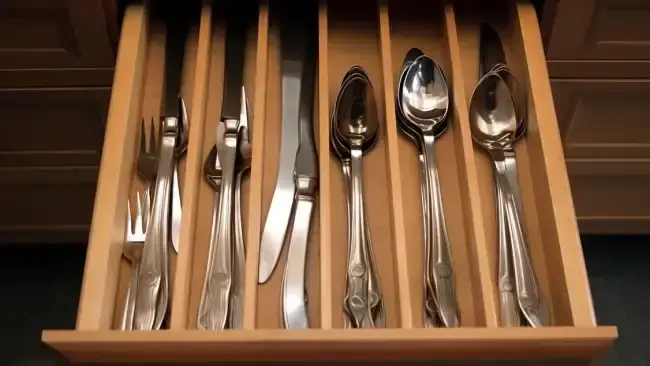
To prevent flatware from scratching when stored in flatware storage, you need to do these things:
1. Use a Flatware Organizer
Consider using a flatware organizer to keep your utensils separated and protected. These organizers have individual compartments for each utensil, preventing them from coming into contact and scratching each other.
Keeping your flatware organized in a flatware organizer allows you to easily find the utensils you need without rummaging through a jumbled mess. It helps prolong the lifespan of your flatware by reducing the risk of damage.
2. Magnetic Strips
You can easily attach magnetic strips to the inside of your drawer or storage container and let your flatware stick to them. This method prevents any physical contact between utensils.
The magnetic strips provide a convenient and space-saving solution for storing your flatware, allowing you to access and organize your utensils easily.
3. Flatware Roll
Roll up your flatware in the fabric flatware roll, and it will keep each piece isolated and prevent scratching. This practical storage solution offers individual slots for each piece, ensuring that they don’t come into contact with one another.
It also helps to maintain the shine and appearance of your flatware by protecting it from scratches. With the fabric flatware roll, you can easily organize and store your flatware while keeping them in pristine condition.
4. Silicone Liners
Consider using silicone liners in your larger compartments or drawers to protect your flatware from scratches. These liners act as a cushioning layer, bridging your flatware pieces.
5. Separate Metals
If you mix silver-plated, gold, stainless steel, or other metals in your flatware collection, store them separately to prevent contact corrosion.
When different metals come into contact with each other, a chemical reaction can occur, causing damage to your flatware.
To keep your silver-plated and gold flatware looking their best, store them in a separate compartment or drawer to avoid any potential corrosion from the stainless steel pieces.
6. Avoid Moisture
Moisture and temperature fluctuations can cause damage to wooden or plastic-handled flatware over time. When exposed to moisture, the wooden or plastic handles can warp, crack, or become discolored.
Temperature fluctuations can also cause the handles to expand and contract, leading to further damage.
To prevent moisture damage, keep your wooden or plastic-handled flatware away from areas where moisture is present. This includes damp basements, bathrooms, and kitchens with high humidity levels.
It’s also important to avoid exposing your flatware to extreme temperature fluctuations, such as those that occur in attics or garages.
These areas can become very hot in the summer and very cold in the winter, which can cause damage to your flatware.
FAQ’s: Should Flatware Be Pointed Up or Down in Storage
We have found that many people have questions regarding the storage of flatware. Listed below are a few of them, and we hope you find them useful.
What is the best grade of stainless steel flatware?
You’ll find that the highest quality stainless steel flatware is typically 18/10 stainless steel. It’s known for its exceptional quality, with extra heavyweight and sturdiness.
The ’18/10′ composition includes 18% chromium for corrosion resistance and 10% nickel for a brilliant shine. This combination makes 18/10 flatware long-lasting, durable, and aesthetically pleasing.
How should I store flatware for long-term storage?
A sealable container with dividers separates different types of utensils and protects your flatware during long-term storage.
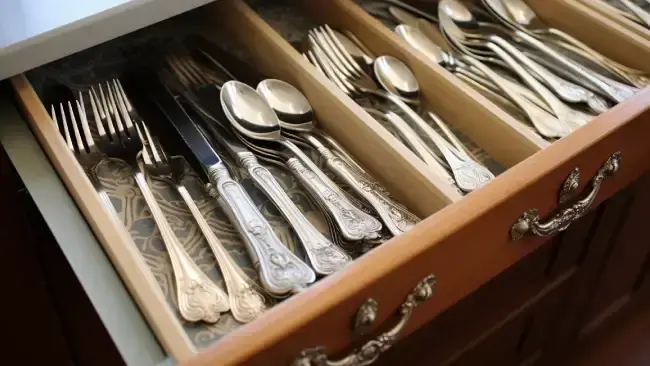
This method ensures that your flatware remains in excellent condition when not in use for extended periods.
Lining the container with a soft fabric like velvet helps prevent scratches and blunting during handling and storage.
Conclusion
Whether you point your flatware handles up or down in your flatware storage, the decision ultimately hinges on your individual preferences and priorities.
Each approach has its own set of advantages and disadvantages, ranging from hygiene and safety concerns to preventing nesting and scratching. But our suggestion is to always store knives with the handles facing up.
Consider your specific needs and habits when choosing, and use organizers, magnetic strips, and rolls to prevent flatware from scratching.
With careful consideration and the right storage techniques, your flatware will remain in excellent condition for a long time.


